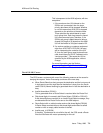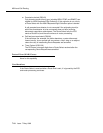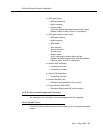
ASAI and Call Routing
Issue 7 May 1998
7-11
Route End
This capability is sent by the ECS to terminate the routing association and inform
the adjunct regarding the outcome of the route. In addition, the adjunct uses this
capability to terminate routing.
Information Flow
There is no expected response to the Route End.
Route End Parameter(s)
cause The ECS issues a Route End for one of the following reasons:
■ User busy (CS0/17)
The destination is busy and does not have coverage. For this
case, the caller hears either a reorder or busy tone.
■ Call with requested identity has been terminated (CS3/86)
The call was dropped while waiting for a routing response.
■ The call has been routed successfully (CS0/16)
■ The call has been redirected (CS3/30)
The ECS has canceled/terminated any outstanding Route
Requests for the call after receiving the first valid Route Select
message. The ECS sends a Route End with this cause to all
other outstanding Routing associations for the call.
■ Invalid Information Element Contents (CS0/100)
Either the UUI information element was longer than 32 bytes, or
the header was missing.
For the above causes, vector processing does not continue. In the
following causes, vector processing continues.
■ Cancelling Outstanding Route Requests
All outstanding Route Requests for a call are cancelled when a
step other than “wait,” “announcement,” “goto,” “stop,” or
“adjunct route” is encountered (cause value CS0/102). In
addition, blank vector steps do not cause outstanding Route
Requests to be cancelled.


















